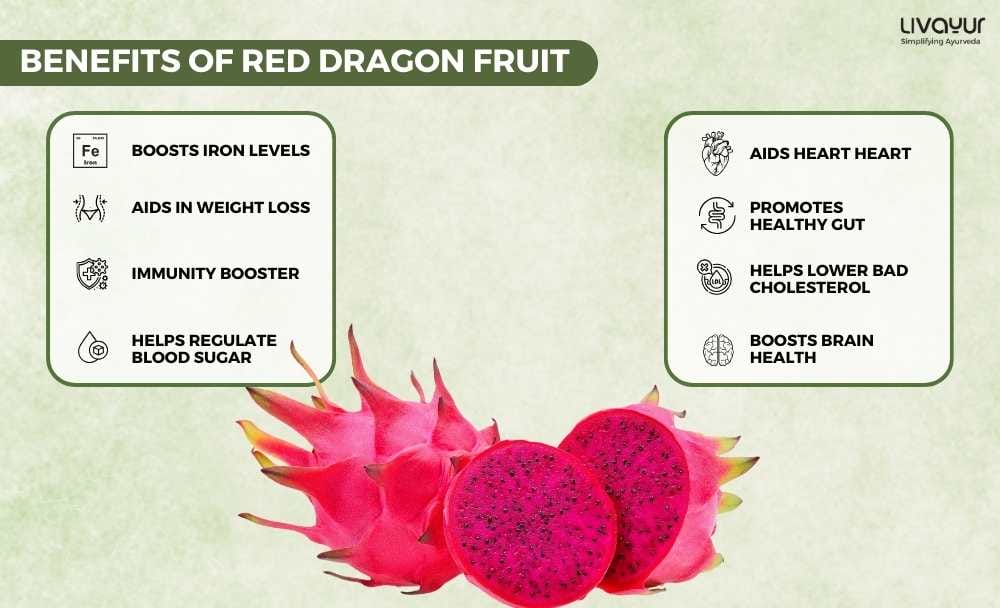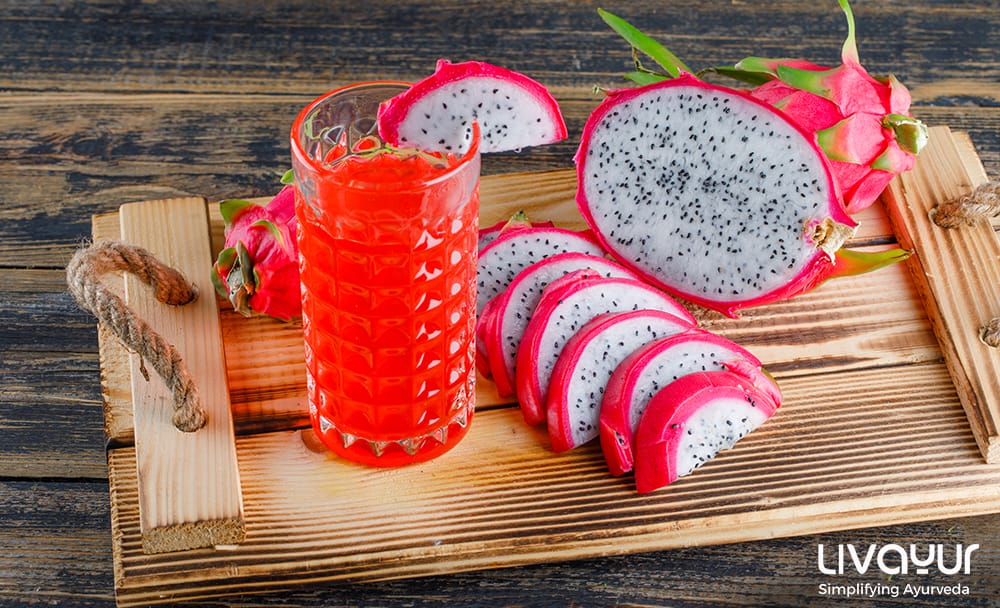This article has been reviewed by experts

Ever wondered why the fruit is called so? Dragon fruit, as the name suggests, resembles a dragon with its outer spikes that shoot up like a flame around the fruit. It is also known as Pitaya or strawberry pear, which is a low-calorie tropical fruit known for its vibrant red or yellow skin, and sweet, seed-speckled pulp. It is a popular fruit among foodies and health enthusiasts due to its unique appearance, and the presence of multiple power-packed nutrients [1].
The red dragon fruit helps address various health conditions [2]. If you have already added this colourful and tasty fruit to your diet, then feel proud of yourself for making efforts to maintain excellent health. But, if you are yet to try dragon fruit, we recommend you should.
Dragon Fruit- A Beautiful Dragon [3]
Dragon fruit is a popular tropical fruit with colourful outer scales like a dragon, with a rich taste. It is also known as Pitaya, strawberry pear, and Honolulu queen (which means the flowers open only at night).
There are two variants of the fruit, namely:
- Red Dragon Fruit- Pitaya Red
It consists of bright red skin with green scales that resemble a dragon.
- Yellow Dragon Fruit- Pitaya Yellow
It has a yellow outer skin and white pulp with black seeds.
Nutritional Value of Red Dragon Fruit [1]
Red dragon fruit is power-packed with several essential nutrients as mentioned below:
| Nutrient | Amount Per 100 g |
| Water Content | 87 g |
| Protein | 1.1 g |
| Fibre | 3 g |
| Carbohydrate | 11 g |
| Fat | 0.4 g |
| Iron | 1.9 mg |
| Calcium | 8.5 mg |
| Vitamins | 3 g |
Surprising Benefits of Red Dragon Fruit We Bet You Never Knew Before

We bring you some of the amazing Pitaya fruit benefits that will make you wonder why you still haven’t included Pitaya in your daily diet!
Promotes a Healthy Gut [4]
- The prebiotic fibre present in the red dragon fruit helps in the growth of good bacteria. This provides you with essential compounds that your body cannot synthesize.
- Dietary fibres also aid in a good bowel movement, thus Pitaya can help treat conditions like constipation, and IBS (irritable bowel syndrome)
Lowers Bad Cholesterol And Improves Heart Health [5]
- The seeds of the fruit are rich in unsaturated fatty acids such as linoleic and linolenic acid which lower the levels of bad cholesterol in your body.
- Furthermore, the presence of phytonutrients like lycopene can improve your vascular health, by lowering the risk of coronary heart disease or heart attacks.
Strengthens Your Immune Systems [6]
- Dragon fruit is packed with antioxidants like vitamin C, betacyanins, and polyphenolic compounds. These help kill harmful pathogens and promote the growth of WBCs (white blood cells).
- Betalains found in the fruit possess anti-inflammatory properties and strengthen your immune system.
Helps Stabilize Your Blood Sugar [7]
- According to several research studies dragon fruit is good for diabetes. This is because the glycemic index of dragon fruit is dose-related. It means that as the amount of dragon fruit consumed increases, the blood sugar levels decrease.
- However, limit the fruit intake, since over-consumption can induce insulin resistance leading to obesity.
Aids In Weight Loss [8]
- The betacyanins found in dragon fruit help in weight loss by managing diabetes, regulating the growth of good bacteria in your gut, and preventing obesity.
- The high fibre and water content of the fruit can help keep you satiated for a longer time.
Boosts Iron Levels [5]
- Dragon fruit is a rich source of iron and vitamin C. Iron is needed for the formation of RBCs (red blood cells) to carry oxygen to different parts of your body, while vitamin C is essential for iron absorption.
- Iron and vitamin C regulate major physiological functions in your body.
Boosts Brain Health [9]
- Regular consumption of dragon fruit may lower the risk of neural degeneration.
- The magnesium content in dragon fruit helps improve brain function and treat depression.
May Promote Reproductive Health [10]
- Dragon fruit benefits in pregnancy may include:
- Prevention of anaemia in mothers
- Improves brain health in the fetus
- Makes the fetal bones strong
- Dragon fruit for libido
- Dragon fruit has aphrodisiac properties (stimulates sex drive) due to the presence of a chemical called phyto albumin which produces more sex hormones.
- Dragon fruit also enables nitric oxide synthesis and boosts blood flow improving the erectile function in males.
Provides Several Skin Benefits Too [5]
- Vitamin C is a potent anti-ageing ingredient that inhibits the breakdown of collagen and hyaluronic acid. It also reduces hyperpigmentation and improves your skin complexion.
- The compounds in dragon fruit also control sebum production and acne breakouts.
- Vitamin B helps lock moisture to keep your skin soft and supple.
The Right Way To Consume It [1]
You can add Pitaya to your diet as a whole fruit or in its powdered form in curd, or smoothies. Dragon fruit can also be included in salads to make them more nutritious. However, seek medical advice if you experience any allergic reactions.
Wrapping up
Red dragon fruit is an exotic fruit with a rich nutrient profile. It has a host of nutritious compounds such as dietary fibres, carbohydrates, minerals, and vitamins B, and C. Pitaya’s health benefits include gut support, and better cardiovascular, and immune health to name a few. Red dragon fruit also offers several skin benefits due to its anti-aging, and antibacterial properties.
FAQs
Can dragon fruit help in dengue?
Dragon fruit contains nutrients like vitamin C, and antioxidants that can boost your immune system and aid in recovery from dengue. However, it cannot cure dengue, and appropriate medical treatment is necessary.
Can dragon fruit be consumed every day?
Yes, you can safely consume dragon fruit every day since it offers several health and skin benefits. However, do not go overboard as it is high in fibre. Introducing high fibre in your diet suddenly can cause flatulence, bloating, and diarrhoea.
What are the common signs of dragon fruit allergy?
There may be a low risk of developing allergic reactions after eating dragon fruit. The signs include:
Tingling or itchy feeling around your mouth
Hives
Swollen lips
Nausea or vomiting
Wheezing
References
- Dragon Fruits as a Reservoir of Natural Polyphenolics with Chemopreventive Properties
- DRAGON FRUIT HERBAL GUTIKA: A POTENTIAL AYURVEDIC DOSAGE FORM FOR MULTIPLE HEALTH BENEFITS
- Dragon fruit (Hylocereus undatus) peel as antioxidant dietary fiber on quality and lipid oxidation of chicken nuggets
- Effects of dragon fruit oligosaccharides on immunity, gut microbiome, and their metabolites in healthy adults – A randomized double-blind placebo-controlled study
- Anti-Inflammatory, Antioxidant, and Other Health Effects of Dragon Fruit and Potential Delivery Systems for Its Bioactive Compounds
- The effect of ingestion of red dragon fruit extract on levels of malondialdehyde and superoxide dismutase after strenuous exercise in rats ( Rattus norvegicus)
- Effect of dragon fruit on glycemic control in prediabetes and type 2 diabetes: A systematic review and meta-analysis
- Dragon Fruit Peel Waste (Hylocereus undatus) is a Potential Ingredient for Reducing Lipid Peroxidation, Dietary Advanced Glycation End Products, and Starch Digestibility in Cookies
- Cultivation, Nutritional Value and Health Benefits of Dragon Fruit (Hylocereus spp.): A Review
- A Review on Plants Used for Improvement of Sexual Performance and Virility

















